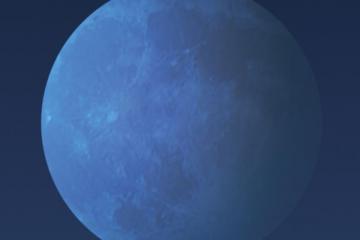July 31, 2015
Tonight's (July 31) moon will be a gorgeous sight, but it won't look different than any other full moon. The term Blue Moon has come to refer to the second full moon in a given month (since full moons come around about every 29 days, most months only contain one).

July 31, 2015
Tonight's (July 31) moon will be a gorgeous sight, but it won't look different than any other full moon. The term Blue Moon has come to refer to the second full moon in a given month (since full moons come around about every 29 days, most months only contain one).

So set your sights skyward tonight, but don't expect a change in the moon's regular hue. NASA explained the July 31 Blue Moon in a video released earlier this week.
However, there are rare occasions when the moon can appear to turn blue. According to the Science@NASA blog, observers have reported the moon having a bluish tint following volcanic eruptions. These explosions send particulates (like ash and smoke) into the air that scatter red light, but let blue light through, creating a natural blue filter and giving the moon a sapphire complexion.
"Back in 1883, for example, people saw blue moons almost every night after the Indonesian volcano Krakatoa exploded with the force of a 100-megaton nuclear bomb," according to the Science@NASA statement. "People also saw blue-colored moons in 1983 after the eruption of the El Chichón volcano in Mexico. And there are reports of blue moons caused by Mount St. Helens in 1980 and Mount Pinatubo in 1991."
Particulates created by forest fires can also create a blue filter in the sky, according to NASA.
"A famous example is the giant muskeg fire of Sept. 1953 in Alberta, Canada," NASA officials explained in the statement. "Clouds of smoke containing micron-sized oil droplets produced lavender suns and blue moons all the way from North American to England. At this time of year, summer wildfires often produce smoke with an abundance of micron-sized particles — just the right size to turn the moon truly blue."
The meaning of the term Blue Moon changed some time during the 20th century. According to the Maine Farmers' Almanac, it once referred to the third full moon in a season that had four (once again, a three-month season typically has only three full moons). But the meaning changed, perhaps because of an article in Sky and Telescope magazine, which mistakenly used blue moon to refer to the second Blue Moon in a single month.
While the moon usually appears full for an entire day or longer, a full moon is actually an instantaneous event. Today's full moon took place at exactly 6:43 a.m. EDT (1043 GMT), but you can enjoy the view of the Blue Moon through the night.
Courtesy: Space.com












































































































